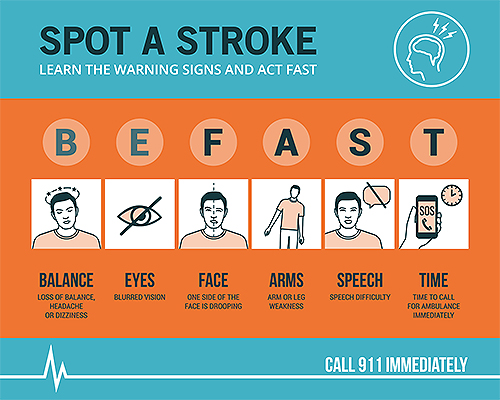What is Stroke
 A stroke occurs if the flow of oxygen-rich blood to a portion of the brain is blocked. Without oxygen, brain cells start to die after a few minutes. Sudden bleeding in the brain also can cause a stroke if it damages brain cells.
A stroke occurs if the flow of oxygen-rich blood to a portion of the brain is blocked. Without oxygen, brain cells start to die after a few minutes. Sudden bleeding in the brain also can cause a stroke if it damages brain cells.
If brain cells die or are damaged because of a stroke, symptoms occur in the parts of the body that these brain cells control. Examples of stroke symptoms include sudden weakness; paralysis or numbness of the face, arms, or legs (paralysis is an inability to move); trouble speaking or understanding speech; and trouble seeing.
A stroke is a serious medical condition that requires emergency care. A stroke can cause lasting brain damage, long-term disability, or even death.
 If you think you or someone else is having a stroke, call 9–1–1 right away. Do not drive to the hospital or let someone else drive you. Call an ambulance so that medical personnel can begin life-saving treatment on the way to the emergency room. During a stroke, every minute counts.
If you think you or someone else is having a stroke, call 9–1–1 right away. Do not drive to the hospital or let someone else drive you. Call an ambulance so that medical personnel can begin life-saving treatment on the way to the emergency room. During a stroke, every minute counts.
Overview
The two main types of stroke are ischemic (is-KE-mik) and hemorrhagic (hem-ah-RAJ-ik). Ischemic is the more common type of stroke.
An ischemic stroke occurs if an artery that supplies oxygen-rich blood to the brain becomes blocked. Blood clots often cause the blockages that lead to ischemic strokes.
A hemorrhagic stroke occurs if an artery in the brain leaks blood or ruptures (breaks open). The pressure from the leaked blood damages brain cells. High blood pressure and aneurysms (AN-u-risms) are examples of conditions that can cause hemorrhagic strokes. (Aneurysms are balloon-like bulges in an artery that can stretch and burst.)
 Another condition that’s similar to a stroke is a transient ischemic attack, also called a TIA or “mini-stroke.” A TIA occurs if blood flow to a portion of the brain is blocked only for a short time. Thus, damage to the brain cells isn’t permanent (lasting).
Another condition that’s similar to a stroke is a transient ischemic attack, also called a TIA or “mini-stroke.” A TIA occurs if blood flow to a portion of the brain is blocked only for a short time. Thus, damage to the brain cells isn’t permanent (lasting).
Like ischemic strokes, TIAs often are caused by blood clots. Although TIAs are not full-blown strokes, they greatly increase the risk of having a stroke. If you have a TIA, it’s important for your doctor to find the cause so you can take steps to prevent a stroke.
Both strokes and TIAs require emergency care.
Outlook
Stroke is a leading cause of death in the United States. Many factors can raise your risk of having a stroke. Talk with your doctor about how you can control these risk factors and help prevent a stroke.
If you have a stroke, prompt treatment can reduce damage to your brain and help you avoid lasting disabilities. Prompt treatment also may help prevent another stroke.
Researchers continue to study the causes and risk factors for stroke. They’re also finding new and better treatments and new ways to help the brain repair itself after a stroke.
Source: National Institutes of Health

